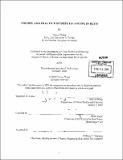| dc.contributor.advisor | Blake Eagle. | en_US |
| dc.contributor.author | Zhang, Huyue | en_US |
| dc.contributor.other | Massachusetts Institute of Technology. Dept. of Urban Studies and Planning. | en_US |
| dc.date.accessioned | 2012-06-05T13:55:07Z | |
| dc.date.available | 2012-06-05T13:55:07Z | |
| dc.date.copyright | 2000 | en_US |
| dc.date.issued | 2000 | en_US |
| dc.identifier.uri | http://hdl.handle.net/1721.1/71105 | |
| dc.description | Thesis (S.M.)--Massachusetts Institute of Technology, Dept. of Urban Studies and Planning, 2000. | en_US |
| dc.description | Includes bibliographical references (leaves 56-57). | en_US |
| dc.description.abstract | Miller and Modigliani's classic finance theory proposes that debt does not add to a firm's value in the absence of corporate tax. Real Estate Investment Trusts (REITs) have no corporate level income tax and meet M & M's perfect market assumption. In reality, however, REIT operators use a significant amount of debt on their balance sheet. There seems to be a contradiction between practice and theory. This thesis developed a statistical model, which demonstrated the relationship between leverage and the cost of equity capital in a sample of 60 equity REITs including four property types. The model indicated a positive relationship between leverage ratio and cost of equity. When a firm adds additional debt, the cost of equity is increased in the form of a higher FFO yield, which is often associated with the decline of stock price. On one hand, the increased debt level increases the required return on equity, and therefore increases the weighted average cost of capital (WACC). On the other hand, the debt is cheaper than the overall return on asset, and the addition of debt lowers the WACC value. The positive and negative effects of a high debt level on WACC are then neutralized. Finally, the model indicated that the WACC value is invariant to the changes of leverage ratios and directionally supported the M & M theory. The model also verified that the size of a firm has an inverse relationship with the cost of equity. The larger firms usually have a lower cost of equity. | en_US |
| dc.description.statementofresponsibility | by Huyue Zhang. | en_US |
| dc.format.extent | 71 leaves | en_US |
| dc.language.iso | eng | en_US |
| dc.publisher | Massachusetts Institute of Technology | en_US |
| dc.rights | M.I.T. theses are protected by
copyright. They may be viewed from this source for any purpose, but
reproduction or distribution in any format is prohibited without written
permission. See provided URL for inquiries about permission. | en_US |
| dc.rights.uri | http://dspace.mit.edu/handle/1721.1/7582 | en_US |
| dc.subject | Urban Studies and Planning. | en_US |
| dc.title | Theory and practice of debt financing in REITs | en_US |
| dc.title.alternative | Debt financing in REITs | en_US |
| dc.title.alternative | Theory and practice of debt financing in real estate investment trusts | en_US |
| dc.type | Thesis | en_US |
| dc.description.degree | S.M. | en_US |
| dc.contributor.department | Massachusetts Institute of Technology. Department of Urban Studies and Planning | |
| dc.identifier.oclc | 45642921 | en_US |
